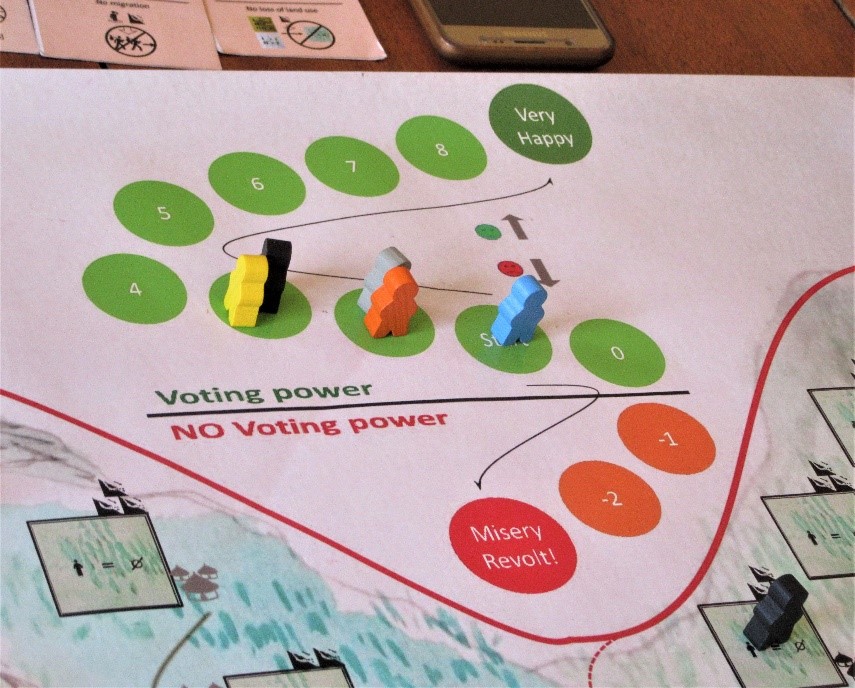Gameplay
The game consists of 5 rounds which represent the 5-year term of service of elected officials in Uganda. Each round (year) consists of 4 phases, namely “the District Council Meeting”, “the rainy season”, “the planting season” and “the population growth and harvest season” (see figure). At the end of the fifth round the satisfaction of the population is compared across players. While there is no explicit purpose to individually ‘win’ the game, this comparison gives an indication of the success of a single player and of the group in the game.
The happiness of the population in a Sub-County is maintained or increased by: (1) passing policies during the district council. (2) accepting refugees (if there are) from other Sub-Counties, (3) effectively preventing that hazards turn into disasters, and (4) not defaulting on the payment of District policies.
At the beginning of every year (i.e. round), all the Sub-County chiefs (i.e. players) come together in the District Council. When policy measures are taken during these District Councils, these measures cost money and apply for the whole district. During the rainy season floods and landslides may happen, depending on the random picking of a ‘disaster card’. In the planting season, players take decisions on investments and land use within their own sub-county. Income, based on decisions during the planting season and population size, is distributed during the harvest season. The next year starts again with a District Council. Policies that can be proposed during the District Council include policies related to “income-generating activities”, “disaster prevention”, “increasing the population’s happiness or satisfaction”, “anti-corruption”, and “population growth management”. Players can formulate their own policy proposals.
Context
The game was developed for the Ugandan context, and in particular for the Rwenzori Mountains in Western Uganda. These mountains are characterized by frequent landslides in the upper Sub-Counties and regular floods in some Sub-Counties in the valleys (Jacobs et al., 2018, 2016; Mertens et al., 2016). The governmental structures for Disaster Risk Reduction (DRR) are dysfunctional in practice (Maes et al., 2017) and great inequalities in access to government and facilities exist between Sub-Counties in the mountains and those in the lowlands. This leads to regular tensions, which are sometimes framed across ethno-cultural identities (KRC and RFPJ, 2012).
In this context, and given a tendency among development agencies to frame problems around disaster risk reduction in an apolitical, consensual way, the game was developed in order to highlight, and make tangible, inequalities, power (im)balances and the importance of assertive discussions in the process of developing and implementing effective disaster risk management plans. As such, the game aims at enhancing political literacy among the players, thereby promoting the development of sustainable, just and democratic disaster risk management policies.
Jacobs, L., Dewitte, O., Poesen, J., Sekajugo, J., Nobile, A., Rossi, M., Thiery, W., Kervyn, M., 2018. Field-based landslide susceptibility assessment in a data-scarce environment: the populated areas of the Rwenzori Mountains. Nat. Hazards Earth Syst. Sci., Submitted to: Natural Hazards and Earth System Sciences. 18, 105–124. https://doi.org/10.5194/nhess-18-105-2018
Jacobs, L., Maes, J., Mertens, K., Sekajugo, J., Thiery, W., van Lipzig, N., Poesen, J., Kervyn, M., Dewitte, O., 2016. Reconstruction of a flash flood event through a multi-hazard approach: focus on the Rwenzori Mountains, Uganda. Nat. Hazards 84. https://doi.org/10.1007/s11069-016-2458-y
KRC, RFPJ, 2012. Stuck in the mist Contextual analysis of the conflicts in the Rwenzori region. https://doi.org/10.1016/j.devcel.2004.09.002
Maes, J., Poesen, J., Parra, C., Kabaseke, C., Bwambale, B., Mertens, K., Jacobs, L., Dewitte, O., Vranken, L., de Hontheim, A., Kervyn, M., 2017. Disaster governance-beyond-the-state: Evidence from landslide risk management in Uganda. Environ. Policy Gov. https://doi.org/10.1002/elan.
Mertens, K., Jacobs, L., Maes, J., Kabaseke, C., Maertens, M., Poesen, J., Kervyn, M., Vranken, L., 2016. The direct impact of landslides on household income in tropical regions: A case study from the Rwenzori Mountains in Uganda. Sci. Total Environ. 550. https://doi.org/10.1016/j.scitotenv.2016.01.171
Target group
Benefits
The game aims at raising awareness on the interactions between policy choices, population growth, land use and disasters. It simulates the conflicting nature of policy-decision in which contrasted interests and power relations are playing a role. By playing the game, the players should:
- Learn what are the feedbacks between population growth, land use, and vulnerability to disasters;
- Learn how to reduce the vulnerability to, and impact of, disasters using preparedness and coping strategies;
- Experience that decision making in a context of (sometimes) conflicting interests and rampant corruption is challenging and affects the potential for sustainable environmental planning
The rationale behind the game design is that the choice about which policy measure to take is a political choice. This means that it is subjected to contestation, is limited by budget constraints, depends on trading off different issues and interests within a community, depends on the worldview of the player and will not always satisfy everyone. The game thus aims at political decision making, rather than consensual decision making as is often the case in serious games. As such, the game depicts a realistic image of disaster risk reduction, thereby effectively preparing participants to address real-life challenges in DRR.
Trivia
This game was created as a ‘spin-off’ of the AfReSlide project (http://afreslide.africamuseum.be/) on “Landslides in Equatorial Africa: Identifying culturally, technically and economically feasible resilience strategies” and was driven by voluntary work of several people and subsidies from Vlir-SI. Its main aim was to ‘bring in the politics again’ in the context of disaster risk reduction in Uganda.
The game was played several times in Belgium and Uganda during its development phase in 2017-2018. It was then played 10 times in the end of 2018 with different groups of policy makes, NGO’s and farmers (50 people in total) in the Rwenzori region. These 10 formal game sessions had two objectives:
- Raising awareness on the themes of the game, being the interrelationship between disasters, population growth, development policies and disaster risk reduction policies, and the political aspect of decision making on disaster risk reduction.
- Doing research on the usefulness of such a game for raising awareness. For this research, a particular attention was given to two topics:
- Awareness on interactions between population growth, policy making and disasters
- Awareness on the political dimension of disaster risk reduction
For research purposes, the 10 game sessions have been recorded (film) and all interactions during the game have been transcribed. Also pre-and post-game questionnaires have been administered to the players. This allows for a careful analysis of the impact of the game.
Since effective measurement of impact (success in reaching the objectives) is frequently lacking in serious games, a research project currently aims at addressing this gap. A master thesis is currently in a final phase of analyzing the data. A scientific publication is expected by the end of 2019.
Created by
Type
Price
Number of players
Number of moderators
Duration
Materials
- Game board
- (6×30) families of different colours
- Money coins
- Disaster cards
- Policy Action Cards
- Policies at sub-county level: By-laws
- Policies at District level: Ordinances
Languages







